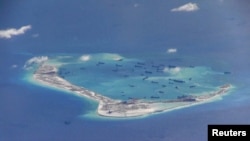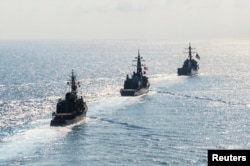A U.S. Navy aircraft carrier strike group has begun "routine operations" in the South China Sea. The operations came despite a warning from China not to interfere with Chinese sovereignty in the area.
The U.S. Navy announced the operations on Saturday. The strike group includes Nimitz-class aircraft carrier USS Carl Vinson.
The Navy Times reported last week on the planned operations with information provided by unnamed Navy officials. The report clearly angered China’s foreign ministry. A foreign ministry spokesman urged U.S. officials “not to take any actions that challenge China's sovereignty and security."
China claims the man-made islands are part of its territory, along with many other parts of the South China Sea. Satellite images suggest China has added military weapons to some of the islands.
Other countries with territorial claims in the sea are the Philippines, Vietnam, Taiwan, Malaysia and Brunei.
Freedom of navigation operation
A U.S. Navy release said the California-based Carl Vinson Carrier Strike Group left last month for a deployment to the western Pacific. A Navy official was reported as saying the deployment would, among other things, contribute “to freedom of navigation and lawful use of the sea.”
Freedom of navigation operation, or FONOP, is meant to show military force and free movement of shipping in international waters. But the operation represents a test to countries holding territorial claims in disputed areas.
China has objected to earlier freedom of movement exercises performed in or around its territory. The U.S. military has carried out at least four FONOP operations in the South China Sea in recent years. The most recent one took place last October, when a U.S. Navy destroyer was sent to waters near Chinese-claimed islands. At the time, a Chinese official called the move “illegal” and “provocative.”
In the past, China has sent military airplanes and/or ships to follow American ships taking part in freedom of navigation exercises.
The U.S. government defends the operations, saying they fully comply with international law. During a recent visit to East Asia, Defense Secretary Jim Mattis said the U.S. military was prepared to hold future freedom of navigation operations in the South China Sea.
Zack Cooper is with the Center for Strategic and International Studies, or CSIS, a research group based in Washington, D.C. He says international law is clearly described in the United Nations Convention on the Law of the Sea.
“Beyond 12 nautical miles from the shoreline, basically any country can fly, sail or operate military vessels in those areas - despite the fact that some countries claim that they can limit that sort of operation.”
Cooper has been watching new U.S. President Donald Trump. He thinks the new U.S. administration is likely to take a more assertive position to freedom of navigation operations in the South China Sea.
Cooper added that the next test for China’s government could be in waters near Mischief Reef, in the Spratly Islands. China has been expanding that man-made island for years and has reportedly built extensive military positions on the reef.
“I would expect that one of the early operations that the Trump administration might do would target Mischief Reef by sailing fairly close to it - demonstrate that the new administration is willing to accept more risk to directly challenge Chinese claims.”
U.S. freedom of navigation operations can send an important message to any state testing international maritime law, he added.
“It's important for the United States and other countries to demonstrate to China that where the law has been made quite clear, that those countries are not going to be intimidated into walking away from what is very clear international law.”
Still, Cooper said, it is not likely that freedom of navigation operations will stop Chinese militarization or existing projects in the South China Sea. But he said it could prevent China from claiming and developing new territory.
China announced changes to its maritime law
China recently announced a proposal to change its own laws controlling how it can react to foreign ships entering its territory. According to the country’s official Global Times, a draft of the law “would empower maritime authorities to prevent foreign ships from entering Chinese waters if it is decided that the ships may harm traffic safety and order.”
Cooper said the revision suggests the law would give China the power to declare control over foreign ships passing through the South China Sea and other major waterways.
“If China was to revise the law in that way, it would again directly contravene the restrictions on those kinds of domestic laws that are in the UN Convention on the Law of the Sea. So in many ways it would be seen I think as a direct challenge to the UN Convention.”
He said other nations should send a strong message to China that they would oppose such changes.
I'm Jonathan Evans.
Bryan Lynn reported this story for VOA Learning English. His report includes information from Reuters, the Associated Press, Navy Times and other sources. George Grow was the editor.
We want to hear from you. Write to us in the Comments section, and visit our Facebook page.
_______________________________________________________________
Words in This Story
navigation – n. moving a boat or ship over an area of water
sovereignty – n. power of a country to control its own government
assertive – adj. confident or strong in speaking or actions
intimidate – v. intentionally make someone afraid
revision – n. a change to something that already exists
provocation – n. something causes anger or action; incitement
comply – v. to do what you have been ordered or asked to do
maritime – adj. of or related to the sea
contravene – v. to fail to follow a rule or law










